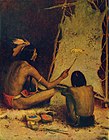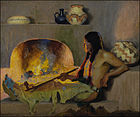
Taos is a town in Taos County in the north-central region of New Mexico in the Sangre de Cristo Mountains. Initially founded in 1615, it was intermittently occupied until its formal establishment in 1795 by Nuevo México Governor Fernando Chacón to act as fortified plaza and trading outpost for the neighboring Native American Taos Pueblo and Hispano communities, including Ranchos de Taos, Cañon, Taos Canyon, Ranchitos, El Prado, and Arroyo Seco. The town was incorporated in 1934. As of the 2010 census, its population was 5,716.

The Taos art colony was an art colony founded in Taos, New Mexico, by artists attracted by the culture of the Taos Pueblo and northern New Mexico. The history of Hispanic craftsmanship in furniture, tin work, and other mediums also played a role in creating a multicultural tradition of art in the area.

Ernest Leonard Blumenschein was an American artist and founding member of the Taos Society of Artists. He is noted for paintings of Native Americans, New Mexico and the American Southwest.

Bert Geer Phillips was an American artist and a founding member of the Taos Society of Artists. He settled in Taos, New Mexico (1898) and was a founder of the Taos art colony. He is known for his paintings of Native Americans, New Mexico, and the American Southwest. He was also a benefactor of the Western artist Harold Dow Bugbee, who became curator of the Panhandle-Plains Historical Museum in Canyon, Texas in 1951.

Eanger Irving Couse was an American artist and a founding member and first president of the Taos Society of Artists. Born and reared in Saginaw, Michigan, he went to New York City and Paris to study art. While spending summers in Taos, he began to make the paintings of Native Americans, New Mexico, and the American Southwest for which he is best known. He later settled full time in Taos.
Oscar Edmund Berninghaus was an American artist and a founding member of the Taos Society of Artists. He is best known for his paintings of Native Americans, New Mexico and the American Southwest. His son, Charles Berninghaus (1905–1988), was also a Taos artist.
Ernest Martin Hennings (1886–1956) was an American artist and member of the Taos Society of Artists.

Walter Ufer was an American artist based in Taos, New Mexico. His most notable work focuses on scenes of Native American life, particularly of the Pueblo Indians.
William Victor Higgins was an American painter and teacher, born in Shelbyville, Indiana. At the age of fifteen, he moved to Chicago, where he studied at the Art Institute in Chicago and at the Chicago Academy of Fine Arts. In Paris he was a pupil of Robert Henri, René Menard and Lucien Simon, and when he was in Munich he studied with Hans von Hayek. He was an associate of the National Academy of Design. Higgins moved to Taos, New Mexico in 1913 and joined the Taos Society of Artists in 1917. In 1923 he was on the founding board of the Harwood Foundation with Elizabeth (Lucy) Harwood and Bert Phillips.

Joseph Henry Sharp was an American painter and a founding member of the Taos Society of Artists, of which he is considered the "Spiritual Father". Sharp was one of the earliest European-American artists to visit Taos, New Mexico, which he saw in 1893 with artist John Hauser. He painted American Indian portraits and cultural life, as well as Western landscapes. President Theodore Roosevelt commissioned him to paint the portraits of 200 Native American warriors who survived the Battle of the Little Bighorn. While working on this project, Sharp lived on land of the Crow Agency, Montana, where he built Absarokee Hut in 1905. Boosted by his sale of 80 paintings to Phoebe Hearst, Sharp quit teaching and began to paint full-time.

The New Mexico Museum of Art is an art museum in Santa Fe governed by the state of New Mexico. It is one of four state-run museums in Santa Fe that are part of the Museum of New Mexico. It is located at 107 West Palace Avenue, one block off the historic Santa Fe Plaza. It was given its current name in 2007, having previously been referred to as The Museum of Fine Arts.

The Ernest L. Blumenschein House is a historic house museum and art gallery at 222 Ledoux Street in Taos, New Mexico. It was a home of painter Ernest L. Blumenschein (1874-1960), a co-founder of the Taos Society of Artists and one of the "Taos Six". It was declared a National Historic Landmark in 1965.
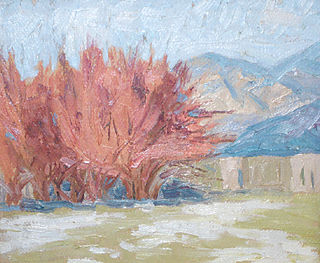
Cordelia Creigh Wilson was a painter noted for her landscapes of New Mexico and the American Southwest.

The Eanger Irving Couse House and Studio—Joseph Henry Sharp Studios, also known as the Couse/Sharp Historic Site, is a property on the U.S. National Register of Historic Places. It includes the home and art studio of E. Irving Couse (1866–1936) and two studio buildings owned by Joseph Henry Sharp (1859-1953), both founding members of the Taos Society of Artists. It was added to the NRHP on September 28, 2005.
Albert Looking Elk, also known as Albert Martinez was a Taos Pueblo painter. Looking Elk is one of the three Taos Pueblo Painters.

The Harwood Museum of Art is located in Taos, New Mexico. Founded in 1923 by the Harwood Foundation, it is the second oldest art museum in New Mexico. Its collections include a wide range of Hispanic works and visual arts from the Taos Society of Artists, Taos Moderns, and contemporary artists. In 1935 the museum was purchased by the University of New Mexico. Since then the property has been expanded to include an auditorium, library and additional exhibition space.
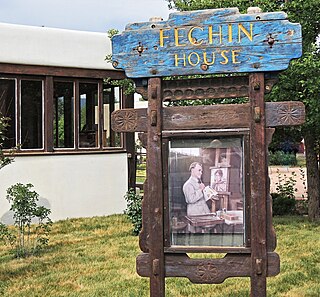
The Taos Art Museum is an art museum located in Taos, New Mexico in the Nicolai Fechin House. This was the home of Russian artist Nicolai Fechin, his wife Alexandra, and daughter Eya. The museum's primary aims are to improve awareness of the works and patronage of Taos artists and to nurture local artistic development. Many of the works of the Taos Society of Artists are held by museums outside of New Mexico, leading them to work to "Bring Taos art back to Taos."

Taos Downtown Historic District is a historic district in Taos, New Mexico. Taos "played a major role in the development of New Mexico, under Spanish, Mexican, and American governments." It a key historical feature of the Enchanted Circle Scenic Byway of northern New Mexico.
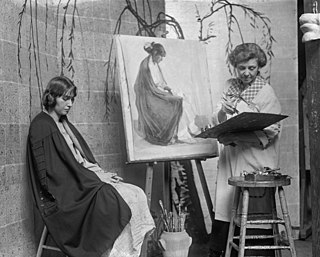
CatharineCarter Critcher was an American painter. A native of Westmoreland County, Virginia, she worked in Paris and Washington, D.C. before becoming, in 1924, a member of the Taos Society of Artists, the only woman ever elected to that body. She was a long time member of the Arts Club of Washington.
A range-finder painting, sometimes called range-finding painting, is a large landscape painting produced as a training device to help gunners improve their accuracy. Historically, the best-documented use of such paintings was in the United States during World War I.

